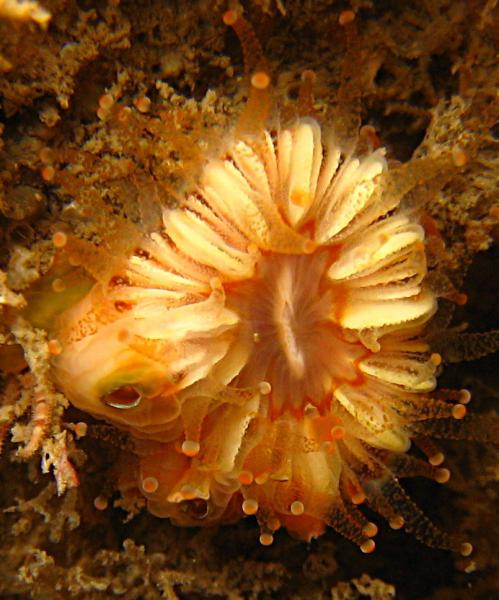
We already knew it, but ecologist Robert Irving amply demonstrated to Coastwise members Lundy’s exceptional qualities in an excellent presentation ranging from the history of Lundy’s marine protection to the wide range of habitats and the marine life which they support and the physical properties on which they depend. Much of the Island is a Site of Special Scientific Interest (SSSI) and the seas surrounding it are England’s first Marine Conservation Zone, and a Special Area of Conservation (SAC).
Looking to the sub-tidal to find most of Lundy’s “specials” Robert introduced us to all 5 British shallow water corals, anemones such as the Policeman’s Helmet and the Weymouth Carpet Coral, the Red-band fish, an eel-like burrower, Red Gurnard and delicate Feather Stars, and many more, each in its distinctive habitat.
The sheltered East side supports a particularly spectacular array of sea fans, branching sponges, crawfish and yellow cluster anemones which have white colour forms in cooler northern waters. They are monitored at Lundy as potential indicators of warming waters, as certain species of Laminaria have been. Research, including recent work on the impact of the No Take Zone, has been a regular feature of Lundy’s marine environment. This has contributed to its protected status culminating recently in its designation as Britain’s first Marine Conservation Zone, though with the Spiny Lobster as its sole protected MCZ feature, Lundy has to look to its SAC status for wider protection.
Lundy has 300 species of seaweed, a record for the area covered, and a greater diversity than on the North Devon coast. The inter-tidal animal species tend to be similar, but the abundance on Lundy, including some less common species, should prove attractive to the North Devon rocky shore-rambler, and the contrast will certainly be instructive.
So why is Lundy Special? Much is due to its Bristol Channel location, the tides and currents, pollution and sediment flow, and varying conditions of its waters through the seasons, and well as the diversity of habitats. Much must also be owed to the good management and concern of those who love Lundy and contribute enormous effort to looking after its interests, which clearly includes our speaker. Robert, together with Keith Hiscock, recently produced the commemorative volume – Protecting Lundy’s Marine Life:40 years of science and conservation. He is also Secretary to the Lundy Marine Conservation Zone Advisory Group, on which Coastwise is pleased to be represented.
(Photos – Cup Coral, Red Sea Fingers and Sea Fan – courtesy Chris Mandry of Ilfracombe Dive Club)

